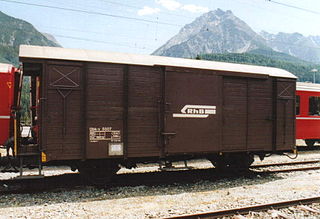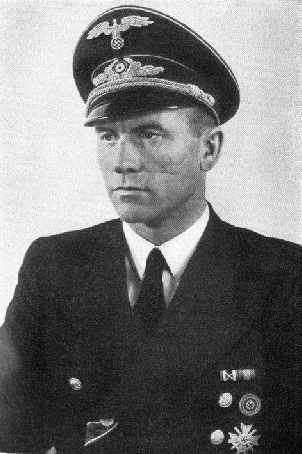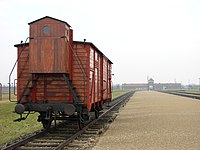
In railroad terminology, a stock car or cattle car is a type of rolling stock used for carrying livestock to market. A traditional stock car resembles a boxcar with louvered instead of solid car sides for the purpose of providing ventilation; stock cars can be single-level for large animals such as cattle or horses, or they can have two or three levels for smaller animals such as sheep, pigs, and poultry. Specialized types of stock cars have been built to haul live fish and shellfish and circus animals such as camels and elephants. Until the 1880s, when the Mather Stock Car Company and others introduced "more humane" stock cars, death rates could be quite high as the animals were hauled over long distances. Improved technology and faster shipping times have greatly reduced deaths.

The Deutsche Reichsbahn, also known as the German National Railway, the German State Railway, German Reich Railway, and the German Imperial Railway, was the German national railway system created after the end of World War I from the regional railways of the individual states of the German Empire. The Deutsche Reichsbahn has been described as "the largest enterprise in the capitalist world in the years between 1920 and 1932"; nevertheless, its importance "arises primarily from the fact that the Reichsbahn was at the center of events in a period of great turmoil in German history".

The Höfle Telegram is a cryptic one-page document, discovered in 2000 among the declassified World War II archives of the Public Record Office in Kew, England. The document consists of several radio telegrams in translation, among them a top-secret message sent by SS Sturmbannführer Hermann Höfle on 11 January 1943; one, to SS Obersturmbannführer Adolf Eichmann in Berlin, and one to SS Obersturmbannführer Franz Heim in German-occupied Kraków (Cracow).

Holocaust trains were railway transports run by the Deutsche Reichsbahn and other European railways under the control of Nazi Germany and its allies, for the purpose of forcible deportation of the Jews, as well as other victims of the Holocaust, to the Nazi concentration, forced labour, and extermination camps.

The German term Verbandsbauart describes both a type of goods wagon as well as a type of tram.

Goods wagons or freight wagons, also known as goods carriages, goods trucks, freight carriages or freight trucks, are unpowered railway vehicles that are used for the transportation of cargo. A variety of wagon types are in use to handle different types of goods, but all goods wagons in a regional network typically have standardized couplers and other fittings, such as hoses for air brakes, allowing different wagon types to be assembled into trains. For tracking and identification purposes, goods wagons are generally assigned a unique identifier, typically a UIC wagon number, or in North America, a company reporting mark plus a company specific serial number.

The system of German railway wagon classes (Wagengattungen) was introduced in Germany in 1902 and 1905 by the Prussian state railways based on their system of norms, and was soon taken up by the other state railways (Länderbahnen). On the formation of the Deutsche Reichsbahn, the system became mandatory across the whole of Germany. In the course of the years more and more adjustments to it were made. It was finally replaced between 1964 and 1968 when the two German railway administrations - the Deutsche Bundesbahn and the Deutsche Reichsbahn - adopted the internationally standard UIC classifications for passenger coaches and goods wagons. Today, the system is still regularly being used for narrow gauge goods wagons, because these were not generally given UIC designations, as well as on many historical vehicles.
The Royal Bavarian State Railways had, at different times, three different goods wagon classification systems that roughly correspond to the early, middle and late period of the state railway era in Bavaria:
The so-called Austauschbauart wagons were German railway vehicles produced from the late 1920s onwards which had common components built to agreed standards.
In German railway engineering, norms (Normalien) are standards for the design and production of railway vehicles. In the 1880s and 1890s, Prussian norms were developed for the locomotives, tenders and wagons of the Prussian state railways under the direction of the railway director responsible for railway engineering, Moritz Stambke. Later, these were largely adopted by the other state railways (Länderbahnen) in Germany.

Kriegsbauart refers to railway goods wagon classes that were developed during the Second World War for the Deutsche Reichsbahn. The start of the war was an arbitrary dividing line for the classification of goods wagons, and did not represent any technological change. In the period shortly before the war, goods wagons were already being designed from a military perspective. This was particularly true for the stake wagons of 1938, which are occasionally referred to as a 'pre-war class' (Vorkriegsbauart) of wagons.
The Victorian Railways used a variety of railway wagons for the transport of livestock.

A covered goods wagon or covered goods van is a railway goods wagon which is designed for the transportation of moisture-susceptible goods and therefore fully enclosed by sides and a fixed roof. They are often referred to simply as covered wagons, and this is the term used by the International Union of Railways (UIC). Since the introduction of the international classification for goods wagons by the UIC in the 1960s a distinction has been drawn between ordinary and special covered wagons. Other types of wagon, such as refrigerated vans and goods wagons with opening roofs, are closely related to covered wagons from a design point of view. Similar freight cars in North America are called boxcars.
The covered goods wagons of classes Glrhs Dresden and Gltrhs Dresden were first placed in service in Germany by the Deutsche Reichsbahn-Gesellschaft in 1937. The wartime (Kriegsbauart) wagon, the DRB Glmhs Leipzig, and the wartime passenger wagon, the DRB MCi-43, were based on the Dresden classes.

A brakeman's cabin or brakeman's caboose (US) was a small one-man compartment at one end of a railway wagon to provide shelter for the brakeman from the weather and in which equipment for manually operating the wagon brake was located. They were built in the days before continuous braking was available and the locomotive brake needed to be augmented by brakemen applying the wagon brakes individually.

Albert Ganzenmüller was a German Nazi and, as the State Secretary at the Reich Transport Ministry (Reichsverkehrsministerium), was involved in the deportation of German Jews.
The wagon with opening roof is a type of railway goods wagon that is, nowadays, defined and standardised by the International Union of Railways (UIC) as Class "T". They are a large category of rail vehicle, predominantly used for the transport of hygroscopic bulk commodities such as cement, plaster, lime, potash and grain.

Lieutenant Franciszek Ząbecki was a station master at the village of Treblinka. During the German occupation of Poland in World War II, Ząbecki worked as a dispatcher for the Deutsche Reichsbahn; he also became a secret soldier in the underground Armia Krajowa (AK), collecting classified data and reporting to the Polish resistance on the Holocaust transports that went to Treblinka extermination camp. Over 800,000 Jews were murdered there in the course of Operation Reinhard, the deadliest phase of the Holocaust in Poland. Ząbecki himself estimated that number to be 1,200,000 people.
Goods wagons of welded construction were developed and built by the Deutsche Reichsbahn in Germany from 1933 to about 1945. With the introduction of welding technology in 1933 almost all wagon components were joined by welding and no longer by rivetting. This enabled goods wagons to be designed, for example, for higher speeds or for higher payloads through the use of different types of steel and other engineering changes, but their further development was so heavily influenced by the exigencies of the Second World War that, as early as 1939, the Deutsche Reichsbahn had to temper the design of goods wagons to the new economic circumstances. Because there were overlaps in the change from the Austauschbauart - goods wagons made with interchangeable components - to the new welded classes, the period of the changeover cannot be exactly defined. Several standard goods wagons and their classes are covered in other articles. Goods wagons built during the Second World War that were purely intended for military transport use, are covered under the article on Kriegsbauart - wartime classes.

Resettlement to the East was a Nazi euphemism which was used to refer to the deportation of Jews and others such as the Roma to extermination camps and other murder locations as part of the Final Solution. The Nazis used the euphemism as an attempt to fool their victims into thinking that they would be "resettled" somewhere else, usually in a labour camp, but not all of the victims believed the claim. The Germans also used the word "evacuation", implying preservation from danger and equally misleading to the victims. The Jews were granted a small luggage allowance, but the luggage was loaded separately, and it was often left at the station so it could be disposed of later, after the trains left. German Jews and their luggage were collected openly and in full view of the public before their transportation to the local railway station. To keep the lie credible, receipts were given, and the luggage was carried separately and collected from the victims after their murder.




















